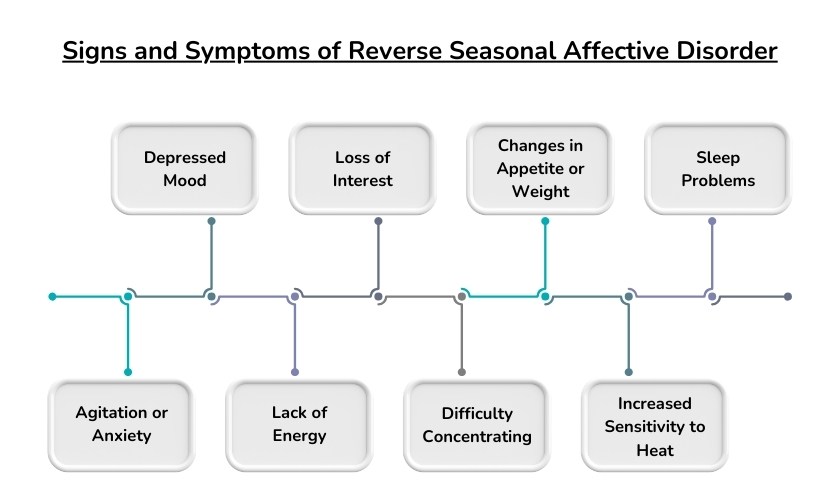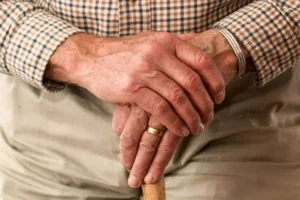Summer is often associated with outdoor activities, vacations, and a generally uplifted mood. However, for some individuals, the sunny season brings about unexpected challenges. Summer Seasonal Affective Disorder (SAD), also known as Reverse Seasonal Affective Disorder, is a subtype of SAD that occurs during the warmer months.
While winter SAD is more widely recognized, affecting around 5% of the US population, summer SAD is lesser-known but still significant, impacting about 10% of those with SAD. These individuals experience depressive symptoms during the summer months, which can significantly interfere with their daily lives and overall well-being.
Understanding the signs, symptoms, and coping strategies for Summer SAD is crucial for those affected and their loved ones.
What is Reverse Seasonal Affective Disorder?
Reverse Seasonal Affective Disorder (SAD), also known as Summer SAD, is a mood disorder characterized by depressive symptoms that occur during the summer months. While most people experience an improvement in mood and energy levels during the warmer seasons, individuals with Summer SAD experience the opposite.
The exact cause of Summer SAD is not fully understood, but factors such as increased heat, longer daylight hours, and disruptions in the body’s internal clock (circadian rhythm) are believed to play a role.
Unlike other forms of depression, individuals with Summer SAD may also experience symptoms such as agitation, anxiety, and increased sensitivity to heat. If left untreated, Summer SAD can significantly impact a person’s quality of life and functioning during the warmer months.
However, with proper understanding and management, individuals with Summer SAD can learn to cope with their symptoms effectively.
Causes of Reverse Seasonal Affective Disorder
The exact cause of Reverse Seasonal Affective Disorder (SAD), also known as Summer SAD, is not fully understood. However, several factors may contribute to the development of this mood disorder. Here are some potential causes of Summer SAD:
- Increased Heat: High temperatures during the summer months can lead to discomfort and disrupted sleep patterns, which may contribute to depressive symptoms.
- Longer Daylight Hours: Extended daylight hours can disrupt the body’s internal clock (circadian rhythm), leading to changes in mood and energy levels.
- Genetics: There may be a genetic predisposition to developing SAD, including both the winter and summer subtypes.
- Serotonin Levels: Fluctuations in serotonin levels, a neurotransmitter that affects mood, may play a role in the development of Summer SAD.
- Melatonin Regulation: Disruptions in the body’s regulation of melatonin, a hormone that regulates sleep-wake cycles, may contribute to symptoms of Summer SAD.
Signs and Symptoms
Recognizing the signs and symptoms of Reverse Seasonal Affective Disorder (SAD), also known as Summer SAD, is crucial for seeking timely support and treatment. While the symptoms of Summer SAD may vary from person to person, common signs to look out for include:

- Depressed Mood: Feeling consistently sad, hopeless, or empty during the summer months.
- Loss of Interest: Losing interest or pleasure in activities that were once enjoyable.
- Changes in Appetite or Weight: Experiencing changes in appetite, leading to weight loss or weight gain.
- Sleep Problems: Having difficulty sleeping or experiencing changes in sleep patterns, such as insomnia or oversleeping.
- Agitation or Anxiety: Feeling restless, irritable, or anxious for no apparent reason.
- Lack of Energy: Experiencing fatigue or a decrease in energy levels, even with adequate rest.
- Difficulty Concentrating: Struggling to focus, make decisions, or remember things.
- Increased Sensitivity to Heat: Feeling more sensitive to high temperatures and humidity than usual.
If you or someone you know is experiencing these symptoms during the summer months, it’s essential to seek support from a healthcare professional for an accurate diagnosis and appropriate treatment.
Coping Strategies
Coping with Reverse Seasonal Affective Disorder (SAD) involves a combination of strategies to manage symptoms and improve overall well-being. Here are some effective coping strategies for dealing with Summer SAD:
Seeking professional help
Consult a healthcare professional: If you suspect you may have Summer SAD, it’s essential to seek support from a doctor or mental health professional for an accurate diagnosis and treatment plan. They can help you understand your symptoms, offer support, and guide you toward effective treatment options.
Psychiatric evaluation: A psychiatric evaluation can help determine if your symptoms are related to Summer SAD or another mental health condition. This evaluation may involve a physical exam, a review of your symptoms and medical history, and possibly lab tests to rule out other medical conditions.
Therapy options
Cognitive Behavioral Therapy (CBT): CBT is a type of talk therapy that focuses on identifying and changing negative thought patterns and behaviors. It can help you develop coping skills and strategies to manage symptoms of Summer SAD.
During CBT sessions, you’ll work with a therapist to challenge negative thoughts, develop problem-solving skills, and learn relaxation techniques to cope with depressive symptoms.
Light therapy: Light therapy, also known as phototherapy, involves exposure to a bright light source that mimics natural sunlight. This exposure can help regulate your body’s internal clock, improve mood, and alleviate symptoms of Summer SAD.
Light therapy is typically administered for 20 to 30 minutes each morning, and you may start to see improvements in your symptoms within a few days to a few weeks.
Medication
Antidepressant medication: In some cases, healthcare professionals may prescribe antidepressant medication to help manage symptoms of Summer SAD. These medications can help regulate neurotransmitters in the brain and alleviate symptoms of depression.
Selective serotonin reuptake inhibitors (SSRIs) and serotonin-norepinephrine reuptake inhibitors (SNRIs) are commonly prescribed antidepressants for the treatment of Summer SAD.
Lifestyle changes
Maintaining a regular sleep schedule: Establishing a consistent sleep routine can help regulate your body’s internal clock and improve sleep quality. Aim for seven to nine hours of quality sleep each night. Try to go to bed and wake up at the same time every day, even on weekends.
Staying active: Regular exercise has been shown to alleviate symptoms of depression and improve overall mood. Aim for at least 30 minutes of moderate-intensity exercise most days of the week. Activities such as walking, swimming, cycling, and yoga can be beneficial for improving mood and reducing symptoms of Summer SAD.
Practicing self-care: Engage in activities that you enjoy and that help you relax. This may include reading, spending time outdoors, practicing mindfulness and meditation, or spending time with loved ones. Taking care of yourself is essential for managing symptoms of Summer SAD and improving your overall well-being.
Seasonal Effective Disorder Lamp
A Seasonal Affective Disorder (SAD) lamp, also known as a light therapy box, is a device that emits bright light to mimic natural sunlight. These lamps are commonly used to treat both Winter SAD and Summer SAD by helping to regulate the body’s internal clock and improve mood.
Individuals who may benefit from using a SAD lamp include those diagnosed with Seasonal Affective Disorder (SAD), including both Winter SAD and Summer SAD.
Additionally, people who experience milder forms of seasonal mood changes, such as the “winter blues” or “summer blues,” may also find relief with light therapy.
However, it’s essential to consult with a healthcare professional before starting light therapy to ensure it’s the right treatment approach for your specific symptoms and needs.
A Word from Excel-Psychiatry
Summer Seasonal Affective Disorder (SAD) can significantly impact individuals’ well-being during warmer months. If you or someone you know is struggling with Summer SAD, seeking professional help is essential. Excel Psychiatry offers comprehensive evaluation and treatment options tailored to your needs. Don’t let Summer SAD diminish your enjoyment of the season—schedule an appointment with Excel Psychiatry today to take the first step toward feeling better.
References
Title: Seasonal Affective Disorder
Written & Published By: NIH (National Institute of Mental Health)
Link: https://www.nimh.nih.gov/health/publications/seasonal-affective-disorder
Title: An Overview of Summer Depression
Written & Published By: Verywell Mind




